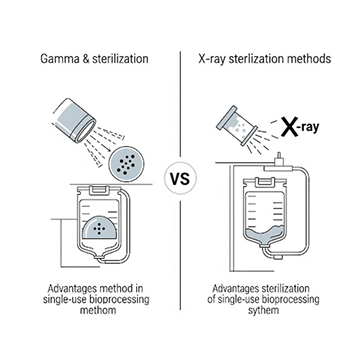
Comparing Sterilization Methods : Gamma vs X-Ray for Single Use Bioprocessing
Comparing Sterilization Methods: Gamma vs X-Ray for Single Use Bioprocessing.
While gamma irradiation is commonly used as a standard for sterilization of single-use systems (SUS) in the biotech industry, an alternative sterilization mode using X-ray irradiation has been introduced. Gamma irradiation sterilization for single-use bioprocessing and medical devices, an essential healthcare technology, is facing critical business continuity challenges, driving the need to qualify equivalent alternative irradiation technologies, such as X-ray.
Gamma irradiation, utilizing Cobalt-60, is the more established method and excels at sterilizing large volumes and thick items. X-ray sterilization, generated by electricity, offers advantages like precise dose control and faster processing, especially for heat-sensitive materials.
A detailed comparison: Gamma vs X-Ray
| Attributes | Gamma Irradiation | X-ray Irradiation |
|---|---|---|
| Source | Uses the radioactive isotope Cobalt-60 | Generates radiation through electric power, eliminating the need for radioactive material |
| Technology | Established Method: Widely used and validated | Emerging Technology: Gaining traction as an alternative to gamma irradiation |
| Strengths | Effective for large volumes and thick items, suitable for a broad range of materials. | Offers precise dose control and faster processing, advantageous for heat-sensitive materials |
| Limitations | Restricted by the availability of Cobalt-60 and irradiation capacity, leading to potential supply chain issues and higher costs | Facilities are less common than gamma irradiation facilities, and transitioning requires revalidation |
Risk Assessment and Evaluation Parameters for Single-Use Bioprocessing
- Irradiation temperatures
- Activation testing
- Materials assessments
- Extractables assessment
The use of X-ray sterilization for single-use systems is an alternative to the industry-standard gamma irradiation. To supplement gamma irradiation with X-ray irradiation capabilities, an empirical evaluation is valuable to demonstrate the integrity, safety, and performance of X-ray irradiation for single-use systems.
Both gamma and X-ray irradiation are viable sterilization methods for single-use bioprocessing. While gamma irradiation remains the established method, X-ray sterilization presents a promising alternative with potential benefits in terms of logistics, processing speed, and dose control.


